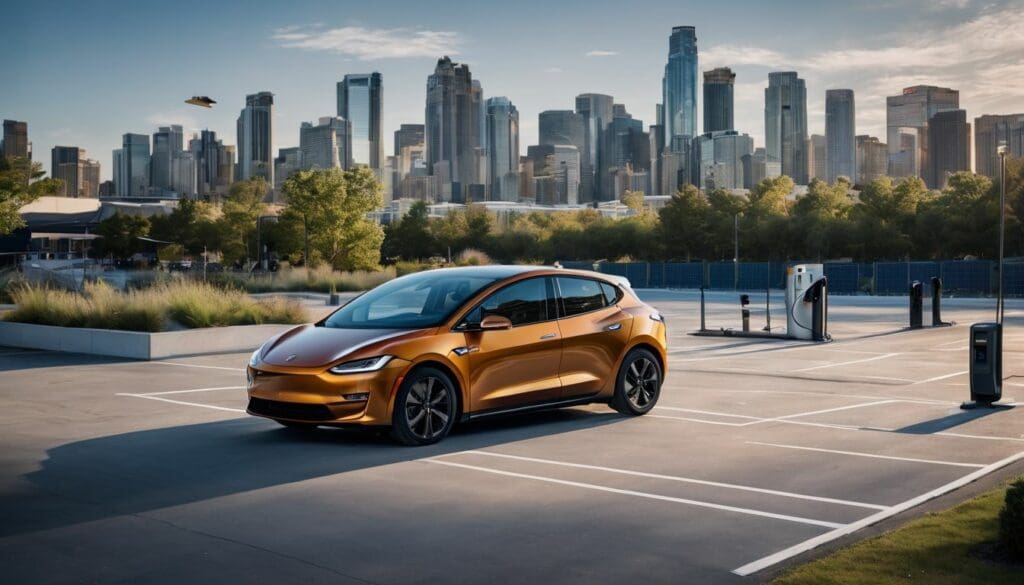As we strive to tread more lightly upon the earth, the quest for sustainable transport has never felt more urgent. We’re all part of this journey, and like you, we’ve been ardently searching for answers that can truly make a difference.
Our latest voyage of discovery has taken us into the heart of the electric vehicle (EV) market—a place where ingenuity and ecological responsibility join hands. With global sales surging by an impressive 40% in just the past year alone, our deep-dive analysis aims to illuminate how EVs are transforming travel with a spark of innovation and a dash of eco-conscious charm.
Join us as we unravel this electrifying narrative and envision a future where our journeys are kinder to our planet.
Key Takeaways
- Electric vehicle sales have surged globally, with a 40% increase in the past year and Europe leading EV adoption due to strong government incentives.
- Technological advances such as improved battery efficiency and electric motors enhance performance and drive range, making EVs more appealing to consumers.
- Environmental benefits of EVs include significant reductions in carbon emissions when compared to gasoline vehicles, aiding efforts against climate change.
- Growth in public charging infrastructure alongside vehicle-to-grid (V2G) technology and smart charging is crucial for addressing range anxiety and supporting widespread EV use.
- Governments play a key role in encouraging electric vehicle usage through subsidies, tax credits, investment in charging stations, and regulatory policies that favour clean energy alternatives.
Historical Data on the Global EV Market
The evolution of the electric vehicle market has seen significant growth in recent years, with an increasing global market size and share. In particular, Europe has shown a strong uptake of EVs, leading to a notable shift in transportation trends.
Evolution of EV Market
Electric vehicles have come a long way from their early prototypes in the 19th century. Initially, they were curiosities, offering silent and clean transportation but lacking in range and speed compared to petrol engines.
During those days, electric cars were luxury items, far out of reach for the average person. Their popularity waned as internal combustion engines dominated the market.
In recent years, we’ve witnessed a remarkable shift as plug-in electric vehicles surge onto roads worldwide. Advances in battery technology have driven this transformation by reducing costs and increasing driving ranges to practical levels.
Major automakers are now committing to an electrified future with new models rolling out each year. Public awareness about climate change is propelling demand for green transportation options like never before; indeed our streets will look very different in just a few short years thanks to this electric revolution.
Global EV Market Size and Share
Transitioning from the remarkable evolution of the EV market, we now delve into the current landscape, assessing the size and share of electric vehicles on a global scale. Here’s a concise view of where the market stands:
| Year | Global EV Sales | Market Share |
|---|---|---|
| 2019 | 2.1 million | 2.5% |
| 2020 | 3.1 million | 4.1% |
| 2021 | 6.6 million | 8.3% |
| 2022 | Projected Growth | Increasing Share |
From this table, we observe a substantial year-on-year increase in global electric vehicle sales, reflecting a growing market share. We, as advocates for sustainability, regard this trend as a positive shift towards a greener future. The sales surge signifies a collective move towards embracing electric mobility, demonstrating the potential for a cleaner transport sector. Let’s keep the momentum going!
EV Market Share in Europe
Transitioning from the global EV market to a more regional outlook, let’s delve into the EV market share in Europe. With an increasing focus on sustainability and environmental protection, Europe has emerged as a key player in the electric vehicle industry. The European Union’s ambitious targets for reducing greenhouse gas emissions have driven substantial growth in the adoption of electric vehicles across the continent.
In recent years, several European countries have implemented incentives and subsidies to encourage consumers to switch from traditional internal combustion engine vehicles to electric ones. As a result, many European nations have seen a significant rise in the market share of electric vehicles, indicating a positive trend towards sustainable transportation.
Types of Electric Vehicles
Electric cars are the most well-known type of electric vehicle, but there are also other types such as buses, trucks, and scooters that have gained popularity in recent years. Each type has its own unique benefits and plays a crucial role in reducing carbon emissions.
Electric Cars
Electric cars are a popular choice for environmentally conscious individuals, as they produce zero tailpipe emissions. These vehicles run on electricity and offer a quieter and smoother driving experience compared to traditional petrol or diesel cars.
Electric cars also contribute to reducing our carbon footprint by decreasing overall air pollution and greenhouse gas emissions.
The electric car market is rapidly growing, with an increasing number of manufacturers producing electric models to meet the rising demand for more sustainable transportation options.
Other EVs (buses, trucks, scooters, etc.)
Other EVs such as buses, trucks, and scooters are increasingly being integrated into the transportation sector in response to environmental concerns.
- Electric buses have gained popularity in urban areas due to their lower emissions and quieter operation.
- Electric trucks are being developed to reduce carbon emissions in freight transportation while also improving energy efficiency.
- Electric scooters offer a sustainable alternative for short-distance travel, contributing to the reduction of air pollution in crowded urban settings.
- Other types of electric vehicles, including e – bikes and electric rickshaws, are providing environmentally friendly solutions for personal mobility in densely populated areas.
EV Charging Trends
The growth of public charging infrastructure and the role of vehicle-to-grid (V2G) and smart charging are shaping the future of EV charging. These trends are essential in addressing range anxiety and promoting widespread adoption of electric vehicles.
Growth of Public Charging Infrastructure
The expansion of public charging infrastructure has significantly contributed to the increasing adoption of electric vehicles. Cities and urban areas have witnessed a surge in the installation of public EV charging stations, making it more convenient for individuals to charge their electric cars on the go.
The availability of reliable and accessible charging points has alleviated range anxiety, allowing more people to consider making the switch to electric vehicles. As a result, this growth in public charging infrastructure has played a pivotal role in accelerating the transition towards sustainable transportation.
Moreover, investment in fast-charging technology and smart grid integration is driving further innovation in EV charging infrastructure. This commitment to enhancing accessibility and speed of charging facilities will be instrumental in encouraging greater uptake of electric vehicles worldwide.
The Role of V2G and Smart Charging
V2G and smart charging play a pivotal role in the electric vehicle (EV) ecosystem. V2G, or vehicle-to-grid technology, allows EVs to not only charge from the grid but also discharge power back into it.
This capability can help balance energy demand and supply on the grid, making it more efficient and reliable. Smart charging refers to the use of advanced technologies to manage when and how EVs are charged, considering factors like electricity prices, grid demand, and renewable energy availability.
By optimising charging patterns, smart charging can reduce strain on the grid during peak times and encourage the use of renewable energy sources for charging.
Implementing V2G and smart charging technologies is essential for maximising the environmental benefits of EVs while ensuring a stable and sustainable energy infrastructure. As more electric vehicles join the market, these innovations will be crucial in managing their impact on electricity grids efficiently.
Development of EV Technology
The rapid development of electric vehicle technology has led to significant improvements in battery efficiency and range, as well as advancements in electric motors for better performance.
These technological innovations have been pivotal in driving the growth of the global electric vehicle market.
Improvements in Battery Technology
Improvements in battery technology drive the growth of electric vehicles, making them more efficient and reliable. Advanced lithium-ion batteries enable EVs to travel longer distances on a single charge, addressing range anxiety for consumers.
Additionally, advancements in battery technology have led to reduced charging times, providing greater convenience for EV owners while contributing to the overall market expansion.
These developments are crucial as they support the wider adoption of electric vehicles and contribute significantly towards reducing carbon emissions from traditional combustion engine vehicles.
Improved battery technology also aligns with efforts to promote renewable energy vehicles and reduce our reliance on fossil fuels.
Advancements in Electric Motors
Electric motors have seen significant advancements in recent years, leading to improved performance and efficiency in electric vehicles. These developments have resulted in higher power density, lower weight, and enhanced durability of electric motors.
Such enhancements have contributed to extending the driving range of electric vehicles while reducing their energy consumption. Additionally, advancements in electric motors have led to reduced maintenance requirements and increased reliability, making electric vehicles a more viable and practical choice for environmentally conscious individuals.
The improvements in electric motors are also facilitating the transition towards sustainable transportation by enabling faster charging times and greater acceleration capabilities in electric vehicles.
Environmental Impact of EVs
Electric vehicles have shown a significant reduction in carbon emissions compared to traditional gasoline-powered vehicles, contributing to the global effort to combat climate change.
Additionally, the adoption of electric vehicles has reduced the demand for energy and oil, leading to a positive environmental impact.
Reduction of Carbon Emissions
Electric vehicles significantly reduce carbon emissions compared to traditional internal combustion engine vehicles. By operating solely on electric power, EVs produce zero tailpipe emissions, directly reducing harmful pollutants in the air.
This plays a crucial role in combatting climate change and improving air quality in cities. The shift towards electric mobility also contributes to lowering overall carbon footprint, as electricity generation from renewable sources such as wind and solar power further minimises environmental impact.
EVs help in curbing greenhouse gas emissions by eliminating the burning of fossil fuels for transportation, thus playing a pivotal role in addressing climate change concerns. The reduced reliance on petroleum-based fuels not only slashes CO2 emissions but also reduces dependence on non-renewable resources, promoting sustainability and conservation efforts.
Impact on Energy and Oil Demand
Electric vehicles significantly reduce the demand for traditional fossil fuels such as oil and gas. With the growing adoption of electric cars, there has been a notable decrease in global energy consumption for transportation.
This shift towards alternative energy vehicles is reshaping the oil market dynamics, leading to reduced reliance on conventional fuel sources and positively impacting energy sustainability.
Furthermore, the increasing deployment of electric vehicles is contributing to a decline in global oil demand. As more individuals opt for battery-powered or plug-in electric vehicles, there is a noteworthy reduction in petroleum usage for powering transportation.
EV-related Policies
Government support and incentives play a crucial role in driving the adoption of electric vehicles, with various countries offering tax credits, grants, and subsidies. The private sector has also responded by investing in EV infrastructure and offering incentives to encourage consumers to make the switch.
Government Support and Incentives
The government plays a vital role in promoting the adoption of electric vehicles through various support and incentives. These measures aim to accelerate the transition to cleaner transportation options and reduce carbon emissions. Here are some examples of government support and incentives for electric vehicles:
- Subsidies and Rebates: Governments provide financial incentives such as tax credits, rebates, and subsidies to make electric vehicles more affordable for consumers.
- Infrastructure Development: Governments invest in the development of EV charging infrastructure, including public charging stations, to address range anxiety and facilitate widespread adoption.
- Incentives for Manufacturers: Governments offer grants or incentives to manufacturers to develop and produce electric vehicles, stimulating innovation and competition in the market.
- Regulatory Policies: Governments implement regulations such as emissions standards and zero-emission vehicle mandates to encourage automakers to focus on producing electric vehicles.
- Research and Development Funding: Government funding supports research and development initiatives for advancing EV technology, including battery improvements and vehicle efficiency.
- Tax Incentives: Tax breaks on electric vehicle purchases, registration, or ownership costs encourage consumers to choose electric over traditional fossil fuel-powered vehicles.
- Public Awareness Campaigns: Governments run public awareness campaigns to educate citizens about the benefits of electric vehicles, promoting their uptake in the market.
- Incentives for Charging Station Installation: Financial assistance or regulatory requirements incentivise businesses and property owners to install EV charging stations at their premises.
Private Sector Response
The private sector has played a crucial role in the rapid growth of the electric vehicle (EV) market. Companies have been investing heavily in research and development to enhance battery technology, improve charging infrastructure, and bring down costs to make EVs more accessible.
Moreover, automobile manufacturers are competing fiercely to launch new models with longer range and improved performance, driving innovation in the industry.
In addition, businesses are collaborating with governments and other stakeholders to build an ecosystem that supports EV adoption. This includes partnerships to expand charging networks, providing incentives for customers, and integrating renewable energy sources into their operations.
As a result, these initiatives are not only accelerating the shift towards sustainable transportation but also setting new benchmarks for corporate responsibility.
Forecasts for the EV Market
We will explore the predicted growth of the EV market by 2030 and discuss strategies to promote EV adoption. We’ll also delve into the global outlook for electric vehicles and their impact on the automotive industry.
Predicted Growth by 2030
The electric vehicle market is expected to experience significant growth by 2030, driven by increasing consumer demand and advancements in technology. The forecasted expansion of the global EV market presents a promising future for environmentally conscious individuals seeking sustainable transportation options. With ongoing developments in battery technology, infrastructure, and government support, the widespread adoption of electric vehicles is anticipated to play a key role in reducing carbon emissions and fostering environmental conservation on a global scale.
The predicted surge in the electric vehicle industry aligns with efforts to address climate change, minimise reliance on traditional fuel sources, and promote sustainable living. As electric cars become more accessible and appealing to consumers due to improving range capabilities and charging infrastructure, the projected growth of the EV market reflects an evolving landscape that prioritises eco-friendly alternatives while driving positive change towards a greener future.
Strategies to Promote EV Adoption
After considering the predicted growth of the EV market, it’s crucial to focus on strategies that will drive widespread adoption. Here are some effective strategies to promote EV adoption:
- Incentives and subsidies for electric vehicle purchases, such as tax credits and rebates, can make EVs more affordable for consumers.
- Expansion of charging infrastructure, including public charging stations in urban areas and along highways, to alleviate range anxiety and encourage long-distance travel.
- Collaboration with businesses to install workplace charging stations, providing employees with convenient access to charging facilities.
- Public education campaigns to raise awareness about the benefits of EVs, dispel myths, and inform consumers about available incentives.
- Encouragement of fleet electrification by offering incentives and support for companies transitioning their vehicle fleets to electric.
Conclusion
As electric vehicles continue to gain traction in the global market, their increasing adoption is reshaping the automotive industry. Government support and technological advancements are driving a significant shift towards sustainable transportation solutions.
With forecasts predicting substantial growth by 2030, strategies promoting EV adoption will play a crucial role in shaping the future of mobility. The ongoing evolution of the electric vehicle market signals a promising transition towards cleaner and greener transportation alternatives for our planet’s future.
FAQs
1. What does the global electric vehicle market analysis tell us?
The analysis provides insights on electric vehicle adoption, market size, growth forecast, and industry trends globally.
2. How quickly is the electric vehicle market growing?
Reports on global electric vehicle outlook indicate significant annual growth in both battery-powered and plug-in electric vehicles markets.
3. Who holds the largest market share in the electric car industry?
Electric Vehicle Market Statistics reveal which manufacturers and countries currently have the highest shares of the market.
4. What trends are shaping the future of electric vehicles?
Global Electric Vehicle Market Trends show a shift towards more sustainable models with forecasts predicting continuous growth in demand for eco-friendly cars.
5. Can I find detailed information about various segments within the EV industry?
Yes, an Electric Vehicle Market Research Report offers extensive data on different segments like plug-in vehicles to analyse current performance and project future developments.





